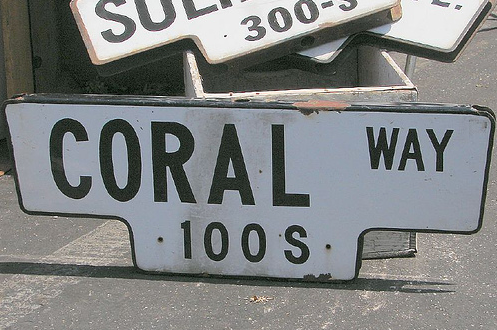
Against the backdrop of what has been a tragic month on South Florida roadways, City of Miami residents and businesses can take solace that the upcoming Coral Way resurfacing project will now include numerous pedestrian safety improvements.
Thanks to the work of District 4 City Commissioner Francis Suarez and the Transit Miami team, the residents of the Coral Way corridor will soon enjoy improved pedestrian and bicycle facilities, as well as a lower 35 mph speed limit as part of the Florida Department of Transportation's upcoming 2.5 mile Coral Way resurfacing project.

The changes to the project come after FDOT officials originally presented designs for the corridor in November 2011, which were panned by advocates and elected officials for lacking pedestrian improvements; the plans maintained the meager crosswalk spacing and high speed design that typifies the corridor today.
 Al all too common sight. Pedestrians on Coral Way are not treated with dignity. The proposed changes are not likely to change this condition (around SW 23 Ave) where no new crosswalks are anticipated.
Al all too common sight. Pedestrians on Coral Way are not treated with dignity. The proposed changes are not likely to change this condition (around SW 23 Ave) where no new crosswalks are anticipated.
Following the initial public meeting, Transit Miami was asked by District 4 staff to compile a list of pedestrian improvements that could be incorporated into the design. As a road resurfacing project, we were mindful that there was a limit to the improvements that could be made without drastically increasing the cost of the project. As such we identified a series of low cost, high impact interventions that could be incorporated into the project, which included:
- Additional north/south crosswalks across Coral Way at every side street intersection -- 13 total
These recommendations were forwarded to Secretary Gus Pego by Commissioner Francis Suarez's chief-of-staff, Mike Llorente, along with a note from that said, "The basic message -- that the contemplated project fails to capitalize on the opportunity to make Coral Way more pedestrian friendly -- is echoed by City Commissioner Suarez and several area residents who attended the community meeting on Wednesday. As you know, the contemplated project does not include any additional pedestrian crosswalks. As a result, pedestrians will continue to have access to only one crosswalk every five blocks, or .5 miles. The lack of crosswalks makes this area very difficult to navigate on foot." (A phenomenon Transit Miami went on to document in a video post.)
After intense lobbying by the commissioner and his staff, FDOT agreed to perform additional pedestrian counts and a speed study to gauge whether demand warranted additional crosswalks and a lower speed limit. Not surprisingly they documented a corridor whose pedestrian activity is growing despite the lack of adequate pedestrian facilities.
The analysis led District 6 staff to include five additional crosswalks across Coral Way; four with flashing beacons, and one new full intersection. In addition, the city will be able to financially contribute to enhanced crosswalks at major intersections, to include raised pavers and timed crosswalk signals. These measures will be accompanied by a reduction in the speed limit to 35 mph (throughout), and the inclusion of bicycle "sharrows" along the entire corridor from 13 Avenue to 37 Avenue. While not all of the recommendations were followed, FDOT agreed to a majority of what Transit Miami recommended.
Though still governed by their 'data driven design' mantra, FDOT's changes to this project should be seen as encouraging news for green mobility advocates because they reflect an increase in pedestrian activity, even as measured by FDOT engineers. District 6 Secretary Gus Pego and Project Manager Ramon Sierra were clear that additional crosswalks could be requested in the near future as the corridor continuesto develop more pedestrian activity. We've been documenting the rise of Coral Way for six years now, and now more than ever the corridor can boast that it has a vibrant future ahead.
Kudos to Commissioner Suarez and his staff for going to bat for complete streets, and major kudos to FDOT for reevaluating their project and working together with elected officials and advocates to make these improvements. We hope that this project is an indication of how we might move forward, together to make our streets safer for all.